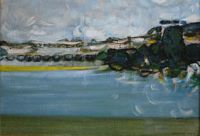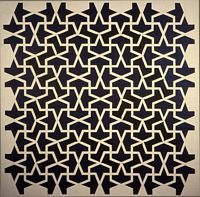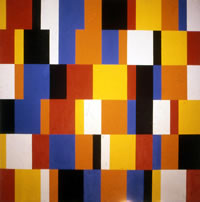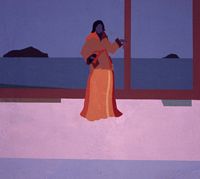The back-story
 My first exhibited paintings were figurative landscapes shown at the New Art Centre, London. But soon, like many painters of my generation, I was caught up in the wave of abstraction which swept the art world in the Sixties.
My first exhibited paintings were figurative landscapes shown at the New Art Centre, London. But soon, like many painters of my generation, I was caught up in the wave of abstraction which swept the art world in the Sixties.
 I had first trained as a scientist. Given this background, contemporary concerns with visual perception and optical phenomena were particularly congenial and a long period of hard-edge painting ensued. (A stint as the first UK editor of Leonardo, the international journal for art and science combined both my interests).
I had first trained as a scientist. Given this background, contemporary concerns with visual perception and optical phenomena were particularly congenial and a long period of hard-edge painting ensued. (A stint as the first UK editor of Leonardo, the international journal for art and science combined both my interests).
I began working in black (or near black) and white. However, even then, my interests were seldom wholly abstract but were rooted in some existing historical tradition for example Islamic lattice patterns, on which I made my own variations. Although this line was never followed-up it did point me in the direction of design, which was to occupy my middle years.
 When I began to tackle the issue of colour I found I could by-pass problems of composition by using simple aleatoric procedures. I would set a few basic rules for the overall distribution of colours, but the actual allocation of each colour to a particular area was decided by the throw of a dice. This method generated structures tantalisingly close to recognisable pattern.
When I began to tackle the issue of colour I found I could by-pass problems of composition by using simple aleatoric procedures. I would set a few basic rules for the overall distribution of colours, but the actual allocation of each colour to a particular area was decided by the throw of a dice. This method generated structures tantalisingly close to recognisable pattern.
 However at this stage, the choice of colours (mostly primaries) was arbitrary. Dissatisfaction with the restricted quality of the colour experience led naturally to a study of colour harmony, starting with an in-depth scrutiny of the usage of colour in Indian miniature paintings. This led in turn to a series of near-abstract variations on the Raga theme. Near-abstract' because while they started from the simplest form possible, a set of nested squares, the imagery soon hinted at the balconies and verandas of the Indian settings, with small clusters of forms alluding to the original figure groups.
However at this stage, the choice of colours (mostly primaries) was arbitrary. Dissatisfaction with the restricted quality of the colour experience led naturally to a study of colour harmony, starting with an in-depth scrutiny of the usage of colour in Indian miniature paintings. This led in turn to a series of near-abstract variations on the Raga theme. Near-abstract' because while they started from the simplest form possible, a set of nested squares, the imagery soon hinted at the balconies and verandas of the Indian settings, with small clusters of forms alluding to the original figure groups.
 From there it was a small step to include the human figure once more, initially in schematic form. Although my working method involved paper cut-outs in the manner of Matisse, the imagery was contemporary, often echoing figures from fashion magazines.
From there it was a small step to include the human figure once more, initially in schematic form. Although my working method involved paper cut-outs in the manner of Matisse, the imagery was contemporary, often echoing figures from fashion magazines.
 Recent painting has been based on a frankly realist approach, accepting contemporary life without irony. By working from source material observed in a desert- or Mediterranean environment, with its bright, sometimes stunning light, I have been able to use the full colour range developed during my non-figurative period. Sometimes I combine elements from both approaches on one canvas.
Recent painting has been based on a frankly realist approach, accepting contemporary life without irony. By working from source material observed in a desert- or Mediterranean environment, with its bright, sometimes stunning light, I have been able to use the full colour range developed during my non-figurative period. Sometimes I combine elements from both approaches on one canvas.
But whatever the subject, each picture stands or falls by the poetry of its colour.
All images are copyright Peter Lloyd Jones